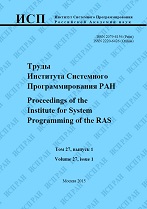|
C# parser for extracting cryptographic protocols structure from source code
I. A. Pisarev, L. K. Babenko
Southern Federal University
Abstract:
Cryptographic protocols are the core of any secure system. With the help of them, data is transmitted securely and protected from third parties' negative impact. As a rule, a cryptographic protocol is developed, analyzed using the means of formal verification and, if it is safe, gets its implementation in the programming language on which the system is developed. However, in the practical implementation of a cryptographic protocol, errors may occur due to the human factor, the assumptions that are necessary for the possibility of implementing the protocol, which entail undermining its security. Thus, it turns out that the protocol itself was initially considered to be safe, but its implementation is in fact not safe. In addition, formal verification uses rather abstract concepts and does not allow to fully analyze the protocol. This paper presents an algorithm for analyzing the source code of the C# programming language to extract the structure of cryptographic protocols. The features of the implementation of protocols in practice are described. The algorithm is based on the searching of important code sections that contain cryptographic protocol-specific constructions and finding of a variable chain transformations from the state of sending or receiving messages to their initial initialization, taking into account possible cryptographic transformations, to compose a tree, from which a simplified structure of a cryptographic protocol will be extracted. The algorithm is implemented in the C# programming language using the Roslyn parser. As an example, a cryptographic protocol is presented that contains the basic operations and functions, namely, asymmetric and symmetric encryption, hashing, signature, random number generation, data concatenation. The analyzer work is shown using this protocol as an example. The future work is described.
Keywords:
cryptographic protocols, C#, parser, verification, tree, analysis, source code.
Citation:
I. A. Pisarev, L. K. Babenko, “C# parser for extracting cryptographic protocols structure from source code”, Proceedings of ISP RAS, 31:3 (2019), 191–202
Linking options:
https://www.mathnet.ru/eng/tisp432 https://www.mathnet.ru/eng/tisp/v31/i3/p191
|

| Statistics & downloads: |
| Abstract page: | 257 | | Full-text PDF : | 106 | | References: | 18 |
|




 Contact us:
Contact us: Terms of Use
Terms of Use
 Registration to the website
Registration to the website Logotypes
Logotypes








 Citation in format
Citation in format 